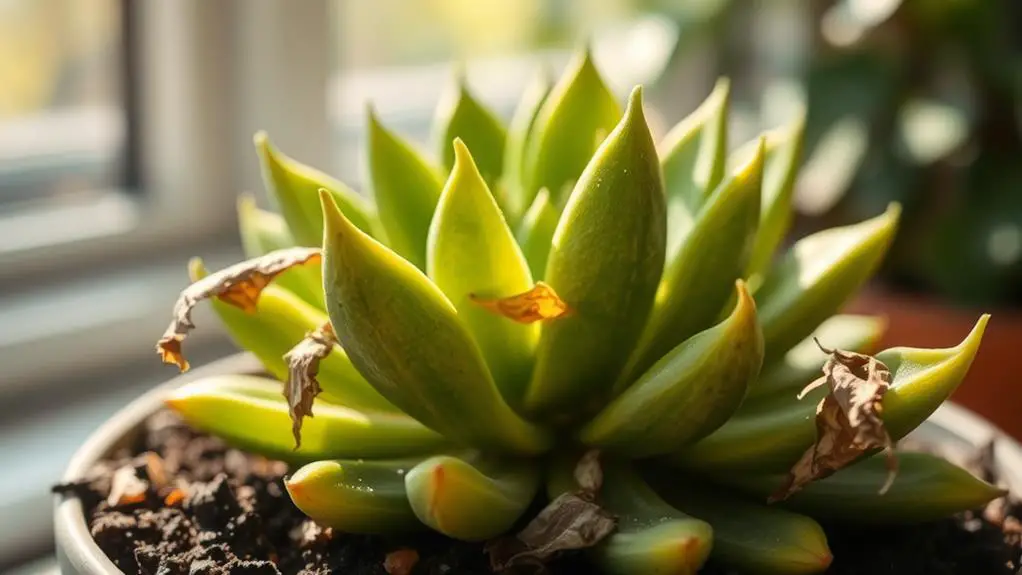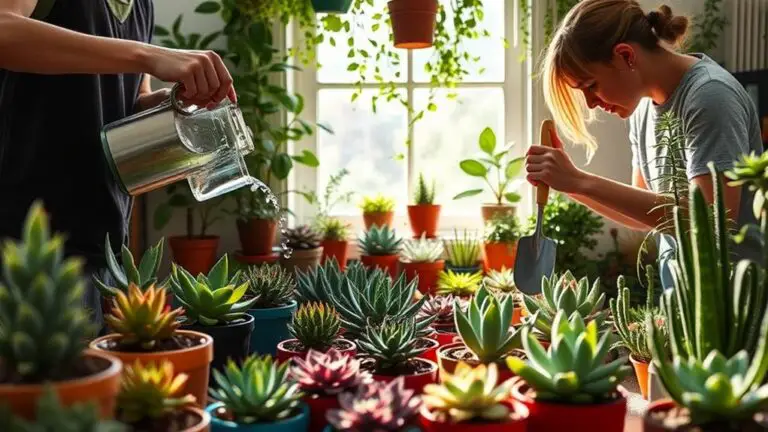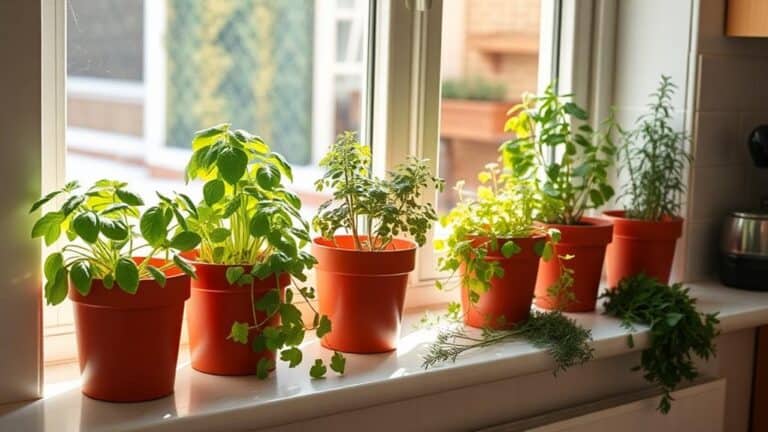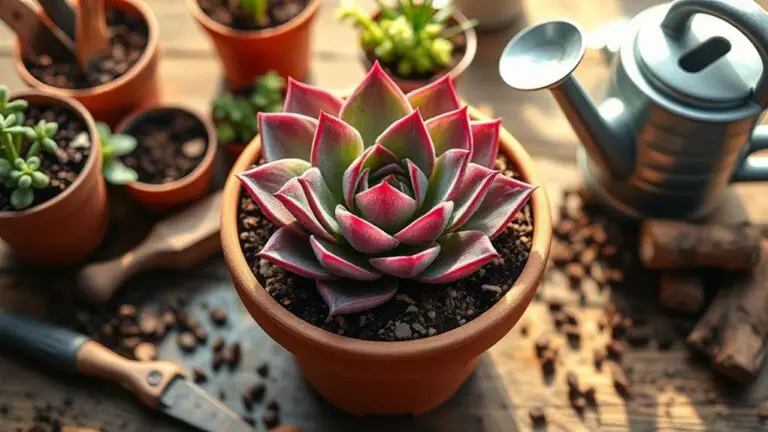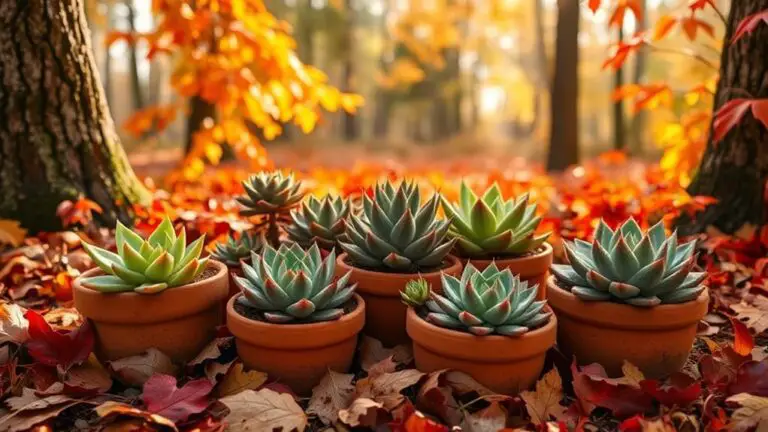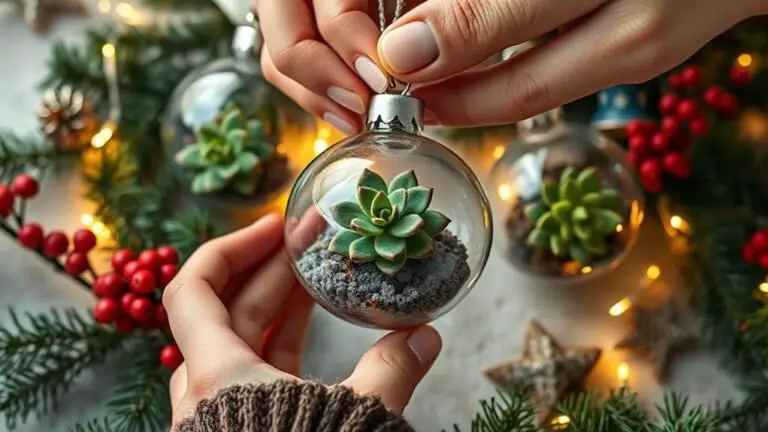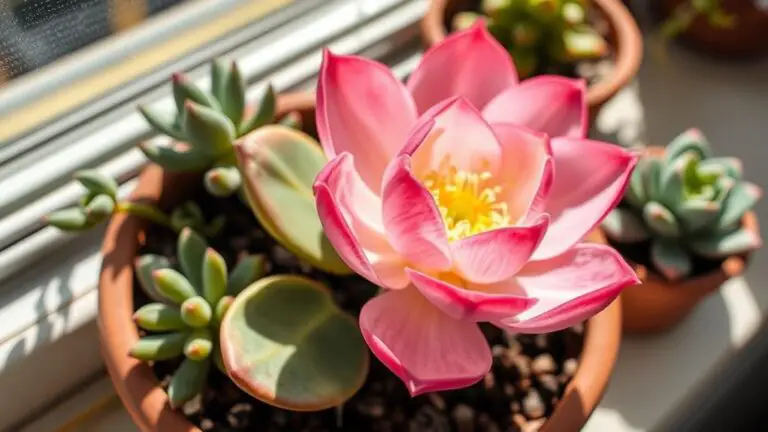Why Are My Succulent Leaves Dropping?
If your succulent leaves are dropping, you might be wondering what you're doing wrong. It's not just one simple answer; several factors could be at play. Overwatering is a common culprit, as it can lead to root rot, but underwatering can stress your plant too. Insufficient light and fluctuating temperatures also play a role. And let's not forget about pesky pests that could be weakening your succulent. To get to the root of the issue, you'll need to take into account all these factors. So, where should you start looking to bring your plant back to life?
Common Causes
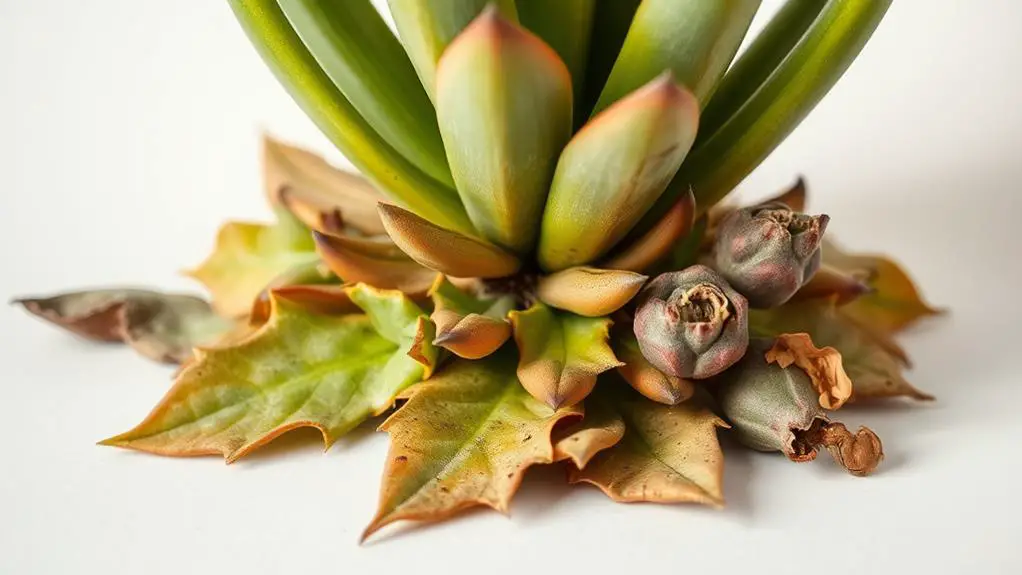
Dealing with succulent leaves dropping? You're not alone, and understanding the common causes can help you keep your plants healthy.
Overwatering is a major culprit. When succulents get too much water, their roots can develop root rot, making leaves mushy and prone to falling off. It's crucial to let the soil dry out between waterings.
Light is another critical factor. Succulents need plenty of bright, indirect sunlight. If they don't get enough light, they stretch towards it, causing the lower leaves to drop. Make sure your succulents are placed in a well-lit spot.
Pests like mealybugs and spider mites can also cause leaf drop. These tiny invaders weaken your plants as they feed on the foliage. Regularly check your succulents for any signs of pests and treat them promptly if you find any.
Extreme temperature changes can stress succulents, leading to leaf drop. Keep your plants away from drafts, radiators, and cold windows. Aim to maintain a stable environment to prevent stress.
Watering Habits
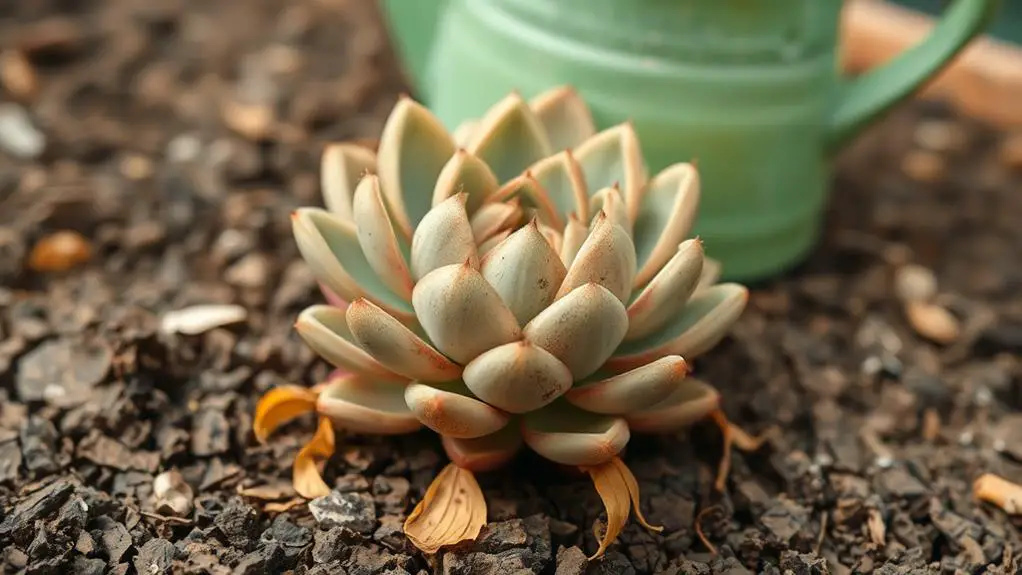
Wondering how to perfect your succulent watering habits? It's easier than you think! Succulent care requires a balance of thorough but infrequent watering. This means you should let the top inch of soil dry out completely before watering again. Overwatering is a common mistake that causes leaf loss, leading to mushy and discolored leaves.
Here's a simple table to guide your watering routine:
| Season | Watering Frequency | Soil Condition |
|---|---|---|
| Spring/Summer | Once every 1-2 weeks | Top inch dry |
| Fall | Once every 2-3 weeks | Top inch dry |
| Winter | Once a month or even less frequently | Top inch dry |
Adjusting your watering habits based on the season is key. During winter, succulents enter a dormant period and require less water. Another tip is to use well-draining soil, which prevents water from accumulating around the roots and causing suffocation and leaf loss.
Before you water, check the soil moisture by sticking your finger into the soil. If it's still moist, hold off on watering. This simple habit promotes healthier growth and reduces stress on your plants. Remember, it's better to underwater than overwater. With these tips, your succulents will thrive!
Pest Management
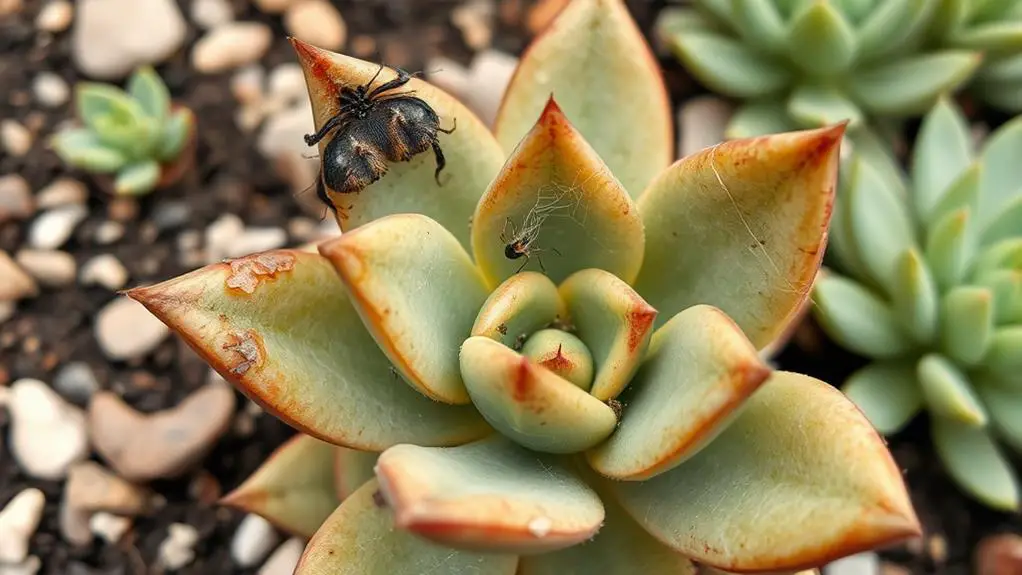
Pests can be a real headache when you're trying to keep your succulents healthy and vibrant. Regularly inspect your plants for signs of pest infestation. Mealybugs, spider mites, and whiteflies are common culprits that can weaken your succulents and cause leaf drop.
Look for yellowing leaves, sticky residue, and webbing on your plants as these are clear indicators that pests are present.
To tackle pest control, consider using insecticidal soap or neem oil. Both are effective treatments, but be sure to follow the application instructions carefully to avoid harming your plant.
Quarantine any affected succulents to prevent the pests from spreading. Isolating them for at least two weeks will give you time to monitor their recovery.
Maintaining a clean environment around your succulents can also help deter pests. A tidy plant area reduces hiding spots and improves air circulation, which minimizes environmental stress on your plants.
Disease Prevention
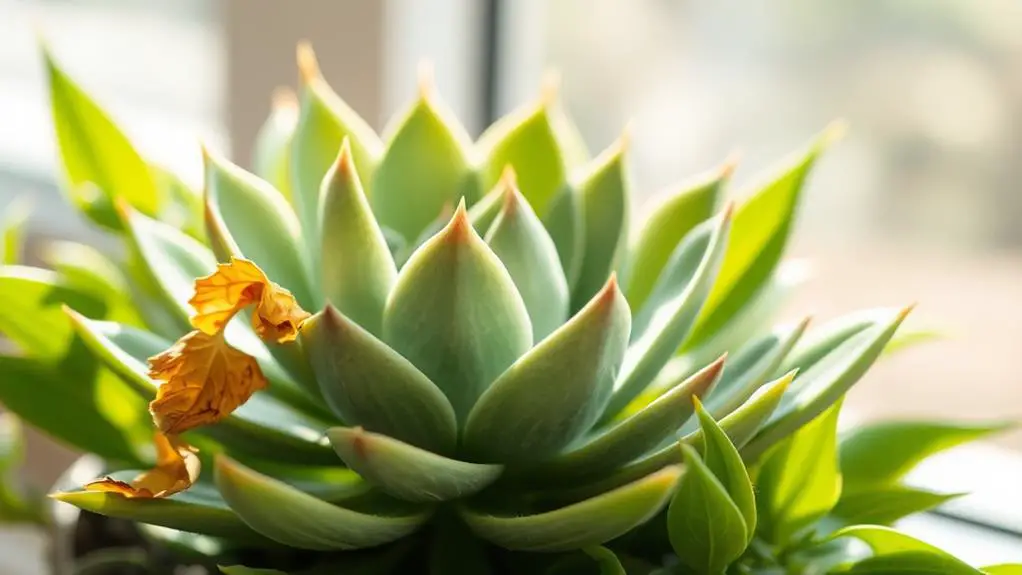
When it comes to disease prevention, regularly check your succulents for any signs of trouble like yellowing leaves or black spots.
If you spot any issues, remove the affected parts right away and consider using an appropriate fungicide.
Rotating your plants to improve air circulation and keeping the area clean from debris can also help keep diseases at bay.
Recognize Disease Symptoms
Identifying disease symptoms in your succulents early can make all the difference in their health and longevity. Dropping leaves are often the first sign that something's wrong. Overwatering is a common culprit, leading to root rot, which can manifest as yellowing leaves and mushy textures.
You should be vigilant about leaf discoloration, as it can indicate various issues. Yellow leaves, for example, might mean your plant is struggling with too much water.
Pay attention to any black, soft spots on leaves or stems. These spots are often symptoms of a fungal infection that demands immediate action. Drooping leaves can also signal underlying diseases affecting root health.
Sometimes, a succulent suffering from disease will show stunted growth—another red flag you shouldn't ignore.
Pest infestations can make matters worse. If you notice a powdery residue or sticky film on your succulent's leaves, you're likely dealing with pests. These pests can lead to more severe diseases if not managed promptly.
Regularly inspect your plants for any unusual growth patterns or leaf discoloration. Early detection is key and can greatly improve your succulent's chances of recovery. Stay observant and proactive to keep your succulents thriving!
Apply Effective Fungicides
For preventing and treating fungal infections that can cause succulent leaf drop, applying effective fungicides is vital. You'll want to pick fungicides specifically labeled for succulents. This guarantees they target the right fungal infections without harming your plants.
Follow the manufacturer's instructions closely for dilution and application frequency. Overdoing it can damage your succulents, so stick to the guidelines.
Apply fungicides during dry conditions. Wet foliage can reduce the treatment's effectiveness, so make certain your plants are dry before you start.
Regularly inspect your succulents for early signs of fungal diseases like leaf spots or discoloration. Catching these symptoms early lets you address them with fungicides before they cause significant leaf drop.
Good air circulation around your succulents is also important. It helps prevent fungal infections from coming back.
Avoid overhead watering, which keeps leaves too wet and creates a perfect environment for fungi to thrive. By being proactive and mindful, you can keep your succulents healthy and vibrant.
Environmental Factors
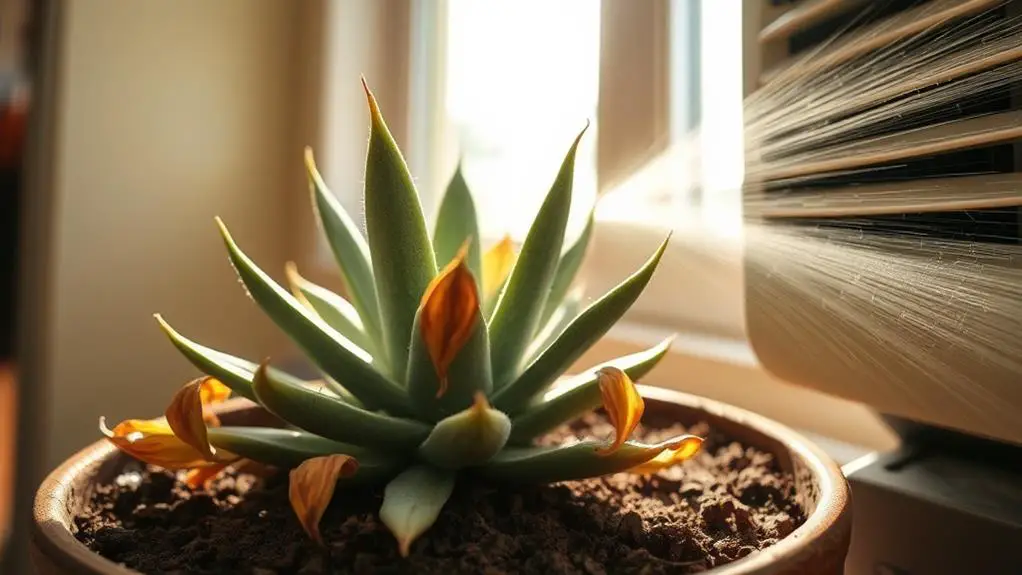
Environmental factors play a big role in the health of your succulents. If they're exposed to extreme temperatures or don't get enough light, their leaves might start dropping as a way to cope.
Also, paying attention to humidity levels and air circulation can help prevent leaf loss and keep your plants thriving.
Temperature Extremes Impact Health
Temperature extremes can considerably impact the health of your succulents, often leading to the dreaded leaf drop. Succulents thrive best in temperatures ranging from 60°F to 80°F (15°C to 27°C). When exposed to temperatures outside this range, your plants can experience stress.
High heat conditions, especially above 90°F (32°C), can cause succulents to drop leaves as they try to conserve moisture, which is essential for their survival. Sudden temperature changes are another culprit. Moving your succulents from a warm indoor environment to a cold outdoor setting can shock them, leading to leaf drop.
Frost is particularly harmful. It can severely damage your succulents, turning their leaves brown, black, or even mushy, indicating cold stress and tissue death.
To help your succulents cope with temperature extremes, maintain good air circulation around them. This practice can reduce the risk of fungal infections that might arise from stress. If you anticipate extreme temperatures, consider moving your succulents to a more stable environment or providing shade and protection when needed.
Inadequate Light Causes Stretching
Noticing your succulent leaves dropping? One common cause is inadequate light, which can make your succulent leaves grow long and leggy. When your plant isn't getting enough light, it starts to stretch towards the nearest light source. This stretching, known as etiolation, results in elongated stems and increased space between the leaves. Over time, this can lead to leaf drop as the plant weakens.
Succulents need bright, indirect sunlight to thrive. If they're kept in low light conditions for too long, they may become more vulnerable to pests and diseases, which can further contribute to leaf loss. To prevent this, place your succulents near south or west-facing windows where they can soak up plenty of natural light.
If natural light is insufficient, consider using grow lights to supplement their needs. Remember to adjust light exposure gradually, as sudden changes can shock the plant.
Humidity Levels Affect Growth
Humidity levels play a significant role in the health and growth of your succulents. These plants prefer low to moderate humidity levels, ideally around 30-50%. When the humidity is too high, it can lead to problems like fungal infections and root rot. High humidity can prevent moisture from evaporating from the leaves, causing them to become mushy and eventually drop.
During winter months, indoor humidity levels often drop, which can stress your succulents. It's important to monitor and adjust the humidity levels to keep your plants healthy. Using a humidity meter can help you maintain ideal conditions and prevent environmental stress.
In high humidity environments, providing adequate air circulation is essential. Good air circulation helps reduce the risk of disease and promotes healthy growth. You can achieve this by placing a fan near your plants or ensuring they've enough space around them for air to flow freely.
Diagnosing Issues
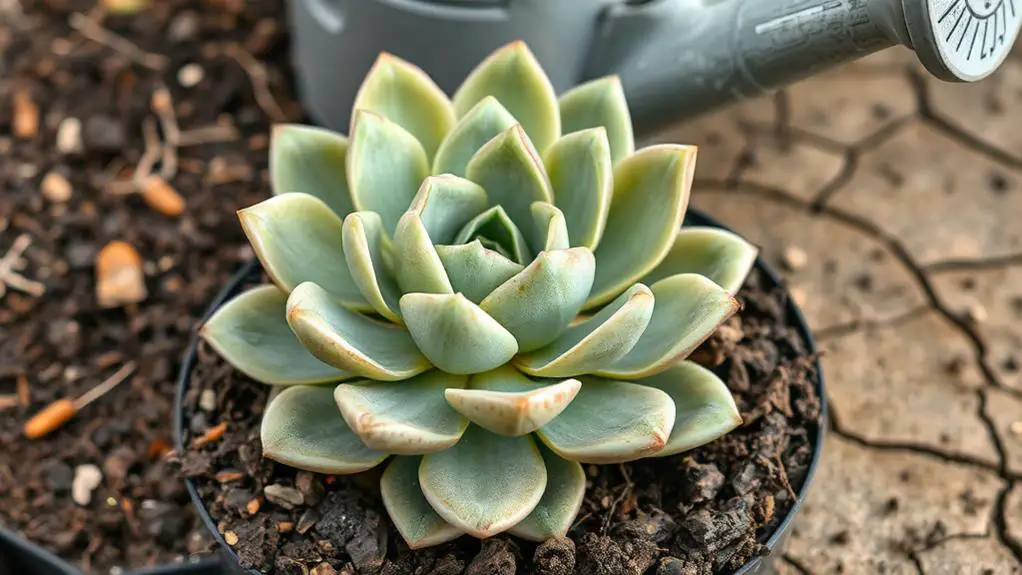
When your succulent starts dropping leaves, it's important to diagnose the issue promptly to prevent further damage. First, inspect the leaves closely. Look for signs of stress like discoloration, mushiness, or a shriveled appearance. These symptoms can signal overwatering or underwatering issues.
Then, check the soil moisture by inserting your finger about an inch deep. If it feels wet, you might be overwatering, which can lead to root rot. It's vital to water your succulents only when the soil is dry.
Next, evaluate the light conditions. If your plant is stretching or growing sideways, it might not be getting enough light. In this case, consider moving it to a sunnier spot.
Also, monitor for pests. Look for sticky residue or webbing. Pests can weaken your plant and cause leaf drop.
Lastly, think about your fertilization habits. Over-fertilizing can cause salt buildup, leading to leaf drop. Feed your succulent only during its active growth season.
Here's a quick reference table:
| Symptom | Potential Issue |
|---|---|
| Discolored leaves | Overwatering |
| Mushy leaves | Overwatering |
| Shriveled leaves | Underwatering |
| Stretching growth | Inadequate light |
| Sticky residue | Pests |
Recovery Strategies
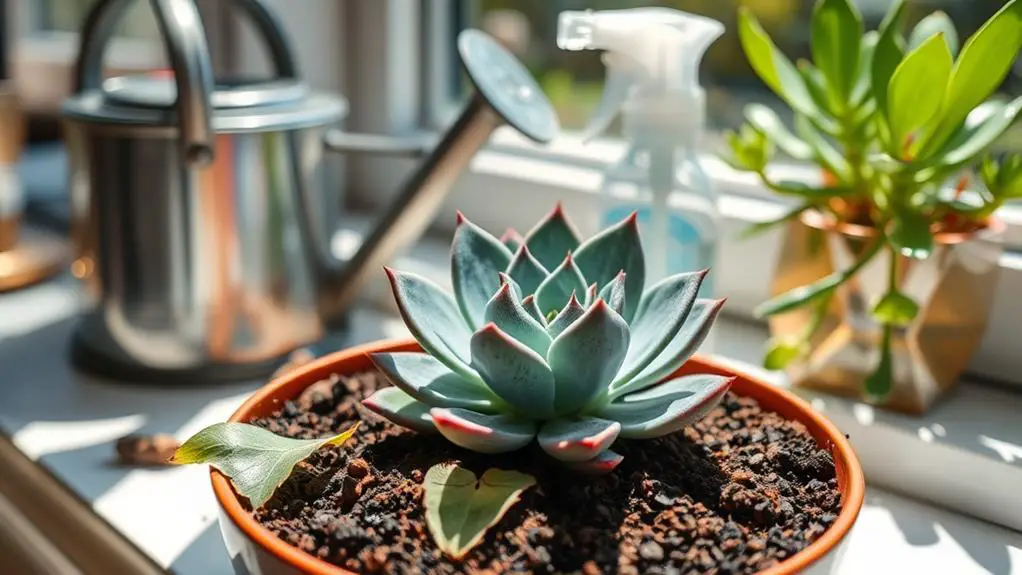
After diagnosing the issue with your succulent, it's time to take action to help it recover. Start by gradually acclimating your plant to brighter light conditions. Move it to a sunnier spot, but do this slowly to avoid shocking the plant. Bright light promotes healthier growth and reduces the risk of further leaf drop.
Next, adjust your watering habits. Succulents don't need much water, so let the soil dry out completely between waterings. Overwatering can lead to root rot, a common cause of leaf drop. When you water, do it thoroughly but infrequently.
If you suspect your succulent has been overwatered, consider repotting it. Use fresh, well-draining soil to give the roots space to breathe and recover. This helps prevent root rot and supports healthier growth.
Limit fertilization to once a month during the active growing season. Over-fertilizing can cause leaf drop too.
Leaf Regrowth Potential
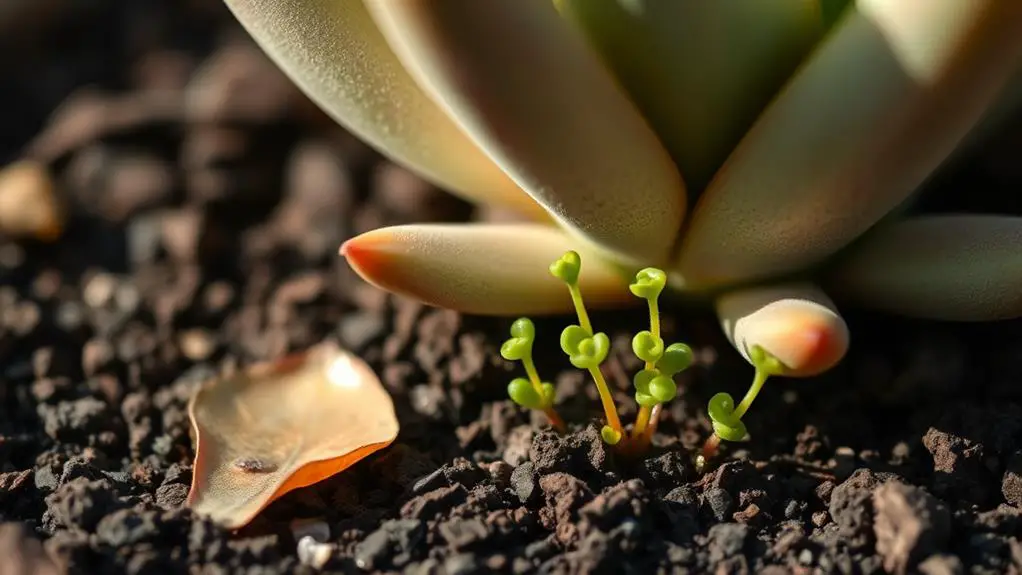
Many succulent enthusiasts wonder about the potential for leaf regrowth after their plants experience leaf drop. It's important to know that once leaves drop from a succulent, they won't regrow in the same position. Instead, the plant will rely on new growth that emerges from offshoots or new heads over time. This process requires patience and proper care to guarantee healthy growth.
Here's what you should keep in mind:
- Propagation: Dropped leaves can be placed on damp soil to propagate new plants. This helps expand your succulent collection.
- Time and Patience: The time it takes for new growth to appear varies by species and environmental conditions. Be patient as the plant recovers.
- Aesthetic Recovery: Bald spots from dropped leaves may become less noticeable as the succulent fills out with new growth, improving its overall look.
- Regular Care: Consistent care and monitoring support recovery and promote healthy growth, increasing the likelihood of successful regrowth.
Understanding the leaf regrowth potential of your succulents can help you manage your expectations and provide the best care possible.
Keep nurturing your plants, and you'll likely see beautiful new growth in time.
General Care Tips
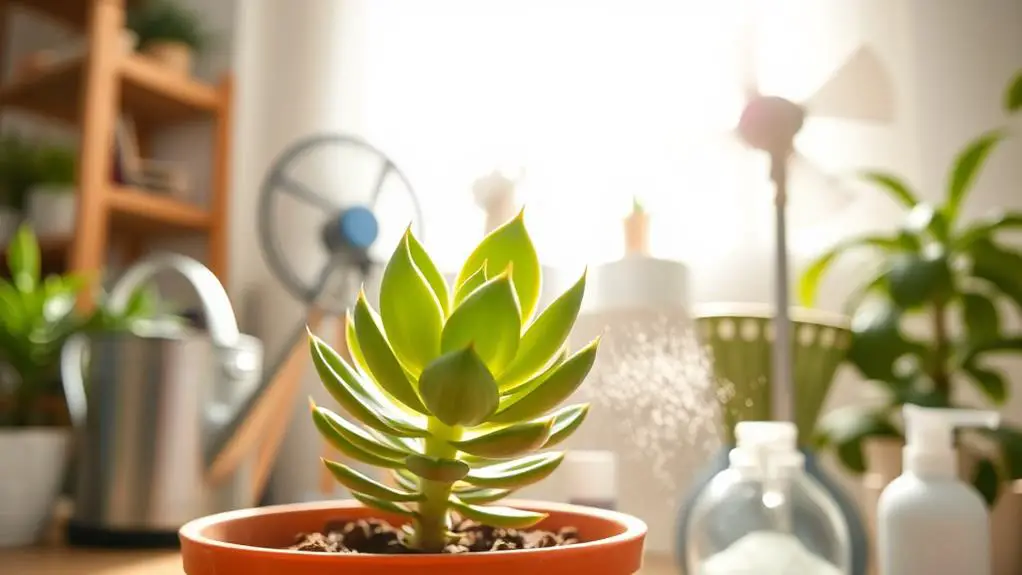
While understanding leaf regrowth potential is significant, guaranteeing your succulents thrive requires consistent general care.
Begin by regularly monitoring your succulents for signs of stress, like leaf drop or discoloration. This helps you catch issues early and take action.
To water succulents properly, give them a thorough soak but wait until the soil is completely dry before watering again. Overwatering can lead to root rot, which is a common cause of leaf drop.
Fertilize sparingly during the growing season. Use a diluted, water-soluble fertilizer no more than once a month. Over-fertilizing can stress your plants.
Adjust care routines with the changing seasons. Confirm your succulents get enough light exposure and maintain a stable temperature. These adjustments help them grow well and stay healthy.
Keeping the area around your succulents clean is essential. Good air circulation prevents pest infestations, another cause of leaf drop.
Make sure there's enough space for air to flow around each plant.
Community Resources
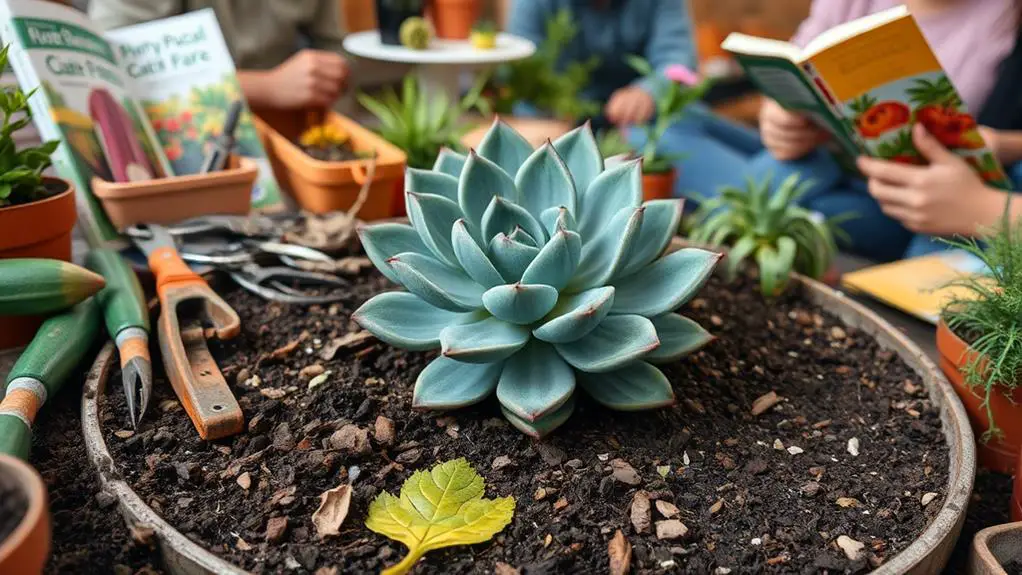
Engaging with community forums and social media groups dedicated to succulent care can offer you invaluable insights and shared experiences regarding leaf drop issues.
Many succulent enthusiasts share their personal care routines and troubleshooting strategies on platforms like Instagram and Pinterest, helping you learn about common problems and solutions.
Shared Knowledge Platforms
Succulent enthusiasts often find shared knowledge platforms invaluable for addressing issues like leaf drop. These platforms provide a wealth of information and community support, helping you tackle leaf drop and other succulent care challenges. Engaging in community discussions can lead to practical solutions and best practices.
Here are some great shared knowledge platforms to reflect upon:
- Online Forums and Groups: Websites and apps dedicated to succulent care let you share experiences and solutions. You'll find advice on watering, pest management, and identifying stressors.
- Social Media Platforms: Instagram and Pinterest feature vibrant communities that share tips, photos, and resources. Following these pages can inspire and educate you on proper succulent care.
- Specialized Websites: Sites like Succulent City offer extensive guides, articles, and troubleshooting tips. These resources explain common problems, like leaf drop, and how to fix them.
- Local Gardening Clubs: Joining local groups or attending plant swap events allows you to gain firsthand advice from experienced growers. These interactions can be incredibly insightful and personalized.
Educational Engagement Opportunities
One of the best ways to deepen your knowledge about succulent care is to take advantage of educational engagement opportunities within your community. Engaging with online forums and social media groups focused on succulent care can be incredibly insightful. You'll find shared experiences that address common issues like leaf drop, helping you identify the best care techniques.
Local gardening clubs and workshops are also fantastic resources. These gatherings allow succulent enthusiasts to discuss plant care, share propagation tips, and solve problems together. You'll get hands-on experience and connect with people who share your passion for succulents.
Educational blogs and articles are another excellent resource. Many plant lovers share their knowledge on identifying symptoms of stress and offer effective care techniques for maintaining succulent health. These writings can be a great reference for troubleshooting issues.
Don't overlook visual platforms like Pinterest and Instagram. They provide visual inspiration and educational content on successful succulent arrangements and care practices. Finally, participating in Q&A sessions or webinars hosted by experienced horticulturists can greatly enhance your understanding of succulent health management.
| Resource | Description |
|---|---|
| Online Forums | Share experiences and get advice |
| Gardening Clubs | Local events for hands-on learning and sharing |
| Educational Blogs | Articles with tips on stress symptoms and care |
| Pinterest/Instagram | Visual inspiration and educational content |
| Webinars/Q&A Sessions | Direct advice from experienced horticulturists |
Frequently Asked Questions
What to Do When Your Succulent Leaves Fall Off?
When your succulent leaves fall off, check your watering schedule, look for pests, guarantee it gets enough light, and verify soil drainage. Remove fallen leaves and be patient. Proper care will help your succulent recover.
What Does an Overwatered Succulent Look Like?
An overwatered succulent has soft, mushy, translucent leaves, often turning yellow. They may fall off easily. The plant's base might smell bad due to root rot, and the roots will appear dark and mushy.
Do Succulent Leaves Grow Back After Falling Off?
Succulent leaves don't regrow in the same spot after falling off. However, new growth can emerge from offshoots or new heads over time. With patience and proper care, your succulent will eventually fill out and look fuller.
How Do You Stop Leaves From Dropping?
To stop leaves from dropping, water only when the top inch of soil is dry. Increase light exposure, avoid over-fertilization, maintain stable conditions, and inspect for pests. These steps will keep your succulents healthy and happy.
Conclusion
You've got this! By understanding why your succulent leaves are dropping, you can take the right steps to help your plant thrive. Whether it's adjusting your watering habits, managing pests, or tweaking the environment, small changes can make a big difference. Stay patient and keep experimenting with what works best for your succulent. Remember, every plant is unique, and with a bit of care, you'll see those leaves regrow in no time. Happy gardening!

